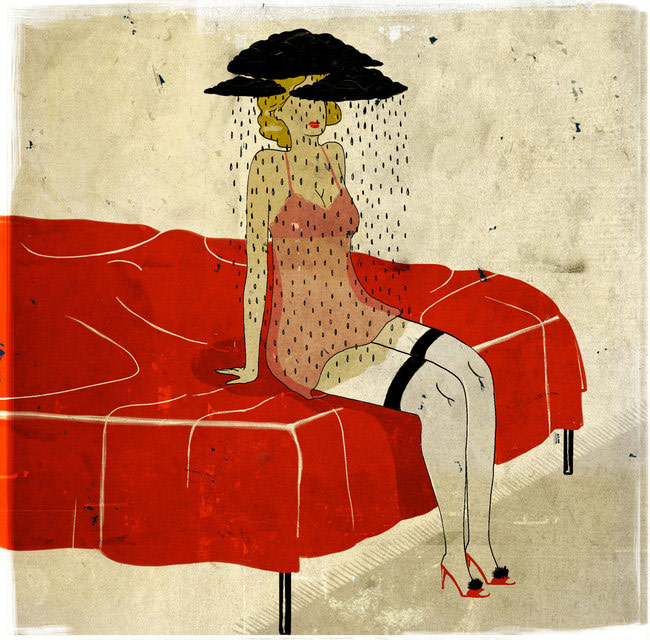| No Sex Please, We’re Middle Class * |
 |
| Written by Camille Paglia |
|
The implication is that a new pill, despite its unforeseen side effects, is necessary to cure the sexual malaise that appears to have sunk over the country. But to what extent do these complaints about sexual apathy reflect a medical reality, and how much do they actually emanate from the anxious, overachieving, white upper middle class?
In the 1950s, female “frigidity” was attributed to social conformism and religious puritanism. But since the sexual revolution of the 1960s, American society has become increasingly secular, with a media environment drenched in sex.
The real culprit, originating in the 19th century, is bourgeois propriety. As respectability became the central middle-class value, censorship and repression became the norm. Victorian prudery ended the humorous sexual candor of both men and women during the agrarian era, a ribaldry chronicled from Shakespeare’s plays to the 18th-century novel. The priggish 1950s, which erased the liberated flappers of the Jazz Age from cultural memory, were simply a return to the norm.
Only the diffuse New Age movement, inspired by nature-keyed Asian practices, has preserved the radical vision of the modern sexual revolution. But concrete power resides in America’s careerist technocracy, for which the elite schools, with their ideological view of gender as a social construct, are feeder cells.
In the discreet white-collar realm, men and women are interchangeable, doing the same, mind-based work. Physicality is suppressed; voices are lowered and gestures curtailed in sanitized office space. Men must neuter themselves, while ambitious women postpone procreation. Androgyny is bewitching in art, but in real life it can lead to stagnation and boredom, which no pill can cure.
Meanwhile, family life has put middle-class men in a bind; they are simply cogs in a domestic machine commanded by women. Contemporary moms have become virtuoso super-managers of a complex operation focused on the care and transport of children. But it’s not so easy to snap over from Apollonian control to Dionysian delirium.
Nor are husbands offering much stimulation in the male display department: visually, American men remain perpetual boys, as shown by the bulky T-shirts, loose shorts and sneakers they wear from preschool through midlife. The sexes, which used to occupy intriguingly separate worlds, are suffering from over-familiarity, a curse of the mundane. There’s no mystery left.
The elemental power of sexuality has also waned in American popular culture. Under the much-maligned studio production code, Hollywood made movies sizzling with flirtation and romance. But from the early ’70s on, nudity was in, and steamy build-up was out. A generation of filmmakers lost the skill of sophisticated innuendo. The situation worsened in the ’90s, when Hollywood pirated video games to turn women into cartoonishly pneumatic superheroines and sci-fi androids, fantasy figures without psychological complexity or the erotic needs of real women.
Furthermore, thanks to a bourgeois white culture that values efficient bodies over voluptuous ones, American actresses have desexualized themselves, confusing sterile athleticism with female power. Their current Pilates-honed look is taut and tense — a boy’s thin limbs and narrow hips combined with amplified breasts. Contrast that with Latino and African-American taste, which runs toward the healthy silhouette of the bootylicious Beyoncé.
A class issue in sexual energy may be suggested by the apparent striking popularity of Victoria’s Secret and its racy lingerie among multiracial lower-middle-class and working-class patrons, even in suburban shopping malls, which otherwise trend toward the white middle class. Country music, with its history in the rural South and Southwest, is still filled with blazingly raunchy scenarios, where the sexes remain dynamically polarized in the old-fashioned way.
On the other hand, rock music, once sexually pioneering, is in the dumps. Black rhythm and blues, born in the Mississippi Delta, was the driving force behind the great hard rock bands of the ’60s, whose cover versions of blues songs were filled with electrifying sexual imagery. The Rolling Stones’ hypnotic recording of Willie Dixon’s “Little Red Rooster,” with its titillating phallic exhibitionism, throbs and shimmers with sultry heat.
But with the huge commercial success of rock, the blues receded as a direct influence on young musicians, who simply imitated the white guitar gods without exploring their roots. Step by step, rock lost its visceral rawness and seductive sensuality. Big-ticket rock, with its well-heeled middle-class audience, is now all superego and no id.
In the 1980s, commercial music boasted a beguiling host of sexy pop chicks like Deborah Harry, Belinda Carlisle, Pat Benatar, and a charmingly ripe Madonna. Late Madonna, in contrast, went bourgeois and turned scrawny. Madonna’s dance-track acolyte, Lady Gaga, with her compulsive overkill, is a high-concept fabrication without an ounce of genuine eroticism.
Pharmaceutical companies will never find the holy grail of a female Viagra — not in this culture driven and drained by middle-class values. Inhibitions are stubbornly internal. And lust is too fiery to be left to the pharmacist.
Camille Paglia, a professor of humanities and media studies at the University of the Arts, is the author of “Sexual Personae.”
|

 Will women soon have a Viagra of their own? Although a Food and Drug Administration advisory panel recently rejected an application to market the drug flibanserin in the United States for women with low libido, it endorsed the potential benefits and urged further research. Several pharmaceutical companies are reported to be well along in the search for such a drug.
Will women soon have a Viagra of their own? Although a Food and Drug Administration advisory panel recently rejected an application to market the drug flibanserin in the United States for women with low libido, it endorsed the potential benefits and urged further research. Several pharmaceutical companies are reported to be well along in the search for such a drug.


